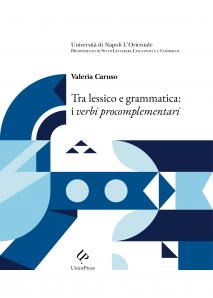Between Lexicon and Grammar: Procomplement Verbs
Keywords:
clitic complement pronouns, multi-word verbs, phraseology, grammaticalizationSynopsis
Publisher: UniorPress
Series: Miscellaneous
Pages: 102
Language: Italian
NBN:
Abstract: The volume investigates the characteristics of procomplement verbs, a heterogeneous class of verbal constructions that, although semantically idiosyncratic, are conjugated together with specific clitic pronouns. Examples include starci (‘be up for it’), risponderne (‘be accountable’), giurarla (‘swear it’), beccarle (‘take a beating’), farsene (‘make use of it’), farcela (‘manage it’), and cercarsela (‘ask for it’).
Previous studies have not followed a unified approach to this unique class of verbs—some framing them as a type of idiomatic expression, others interpreting them as the result of overlapping processes of grammaticalization and lexicalization that have given rise to various subtypes. One line of research has focused on verbal idioms such as saperla lunga (‘to be shrewd’), seeking to identify generalizations that would also apply to simpler forms like saperne (‘to know about’). Other approaches, mostly dealing with procomplement verbs without additional modifiers, emphasize the unpredictability of the clitic’s contribution to verbal meaning—from pragmatic values (che ne sai di me? / ‘what do you know about me?’), to connotative nuance (finiscila! / ‘cut it out!’), aspectual shifts (ci sento / ‘I can hear’, vs. sento bene / ‘I hear well’), and full semantic opacity (chi se ne frega! / ‘who cares!’).
The present contribution adopts a perspective that is closer to the latter line of inquiry, acknowledging the heterogeneity of the class. However, it also identifies certain transversal features of procomplement verbs, which are attributed to two primary types of reference encoded by the lexicalized clitic. On the one hand, there are verbs with anaphoric value, where the clitic refers to or anticipates an element present in the surrounding text (c’è molta simpatia tra loro; ce la farai a superare l’esame). On the other hand, verbs such as prenderle (‘take a beating’), arrivarci (‘get it’, i.e. understand), or attaccarla (‘catch it’, i.e. a disease) involve clitics that lexicalize an implicit argument, which is only made explicit in marked constructions such as left-dislocation: le botte le hanno prese tutte nella caserma di Bolzaneto (‘they all got beaten up in the Bolzaneto barracks’). In the volume, the first type is referred to as anaphoric procomplement verbs, while the latter are called denotative procomplement verbs.
The distinction into the two modes of referentiality have sytanctic ramifications. Denotative procomplement verbs have an unexpressed argument and take a single argument. Anaphoric procomplement verbs, by contrast, complete their meaning with an argument that is recoverable from the co-text or the communicative context. Thus, they take two arguments—at times, with obligatory expression of the second argument (ci ha messo un’ora ad arrivare / ‘it took [him/her] an hour to arrive’).
Following the metalinguistic term coined by De Mauro, procomplement verbs are verbal units conjugated with the help of clitic object pronouns (pro-complemento) that lexicalize either co-textual elements or omitted arguments. This is in contrast to pronominal verbs, which combine with other clitics in a compositional way, grammaticalizing various types of diathesis—as in abbracciarsi (‘hug each other’), vestirsi (‘get dressed’), mangiarsi un panino (‘eat oneself a sandwich’).
These and other insights aim to provide a foundation for the development of a future syllabus of procomplement verbs, based on their semantic-syntactic properties. They also offer an opportunity to reframe the teaching of clitic pronouns by tying them more directly to the verbal lexicon to better explain their meanings and functions.
Downloads















